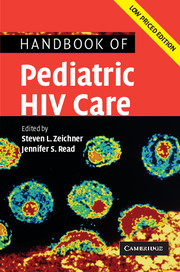Book contents
- Frontmatter
- Contents
- List of contributors
- List of abbreviations
- Foreword
- Preface
- Part I Scientific basis of pediatric HIV care
- Part II General issues in the care of pediatric HIV patients
- 3 Diagnosis of HIV infection in children
- 4 Prevention of mother-to-child transmission of HIV
- 5 Routine pediatric care
- 6 Emergency evaluation and care
- 7 Adherence to antiretroviral therapy in children and youth
- 8 Adolescents and HIV
- 9 Growth, nutrition, and metabolism
- 10 Neurobehavioral function and assessment of children and adolescents with HIV infection
- Part III Antiretroviral therapy
- Part IV Clinical manifestations of HIV infection in children
- Part V Infectious problems in pediatric HIV disease
- Part VI Medical, social, and legal issues
- Appendix 1 Formulary of antiretroviral agents
- Appendix 2 National Institutes of Health sponsored clinical trials for pediatric HIV disease
- Appendix 3 Selected HIV-related internet resources
- Appendix 4 Selected legal resources for HIV-infected children
- Index
- References
8 - Adolescents and HIV
Published online by Cambridge University Press: 23 December 2009
- Frontmatter
- Contents
- List of contributors
- List of abbreviations
- Foreword
- Preface
- Part I Scientific basis of pediatric HIV care
- Part II General issues in the care of pediatric HIV patients
- 3 Diagnosis of HIV infection in children
- 4 Prevention of mother-to-child transmission of HIV
- 5 Routine pediatric care
- 6 Emergency evaluation and care
- 7 Adherence to antiretroviral therapy in children and youth
- 8 Adolescents and HIV
- 9 Growth, nutrition, and metabolism
- 10 Neurobehavioral function and assessment of children and adolescents with HIV infection
- Part III Antiretroviral therapy
- Part IV Clinical manifestations of HIV infection in children
- Part V Infectious problems in pediatric HIV disease
- Part VI Medical, social, and legal issues
- Appendix 1 Formulary of antiretroviral agents
- Appendix 2 National Institutes of Health sponsored clinical trials for pediatric HIV disease
- Appendix 3 Selected HIV-related internet resources
- Appendix 4 Selected legal resources for HIV-infected children
- Index
- References
Summary
Introduction
HIV-infected adolescents represent an important part of the global AIDS epidemic. In this chapter, the epidemiology of HIV infection in adolescents will be addressed, as well as adolescent development, HIV counseling and testing, and prevention of acquisition of HIV infection by adolescents. Finally, management of HIV-infected adolescents, including reproductive health and gynecologic care, will be addressed. It is not the intent of this chapter to review all aspects of management of HIV-infected adolescents, but rather to address issues that are unique to adolescents. This chapter emphasizes adolescent HIV infection as seen in the USA, but many of the principles are applicable to adolescents in other settings.
Epidemiology
The epidemiology of HIV infection among adolescents in the USA generally mirrors the epidemiology of HIV infection among adolescents in other resource-rich countries. In resource-poor countries, the epidemiology of HIV infection among adolescents is somewhat different in that HIV infection disproportionately affects young women, who generally become infected through heterosexual contact, often with older men.
By the end of 2001, the Centers for Disease Control and Prevention (CDC) estimated that adolescents aged 13 to 19 years made up less than 1% (4428 cases), and young adults aged 20–24 years represented 3.5% (28 665 cases), of all reported individuals with AIDS in the USA [1]. It is estimated that over 100 000 adolescents are living with HIV in the USA, although most are unaware of their infection [2].
- Type
- Chapter
- Information
- Handbook of Pediatric HIV Care , pp. 219 - 272Publisher: Cambridge University PressPrint publication year: 2006



